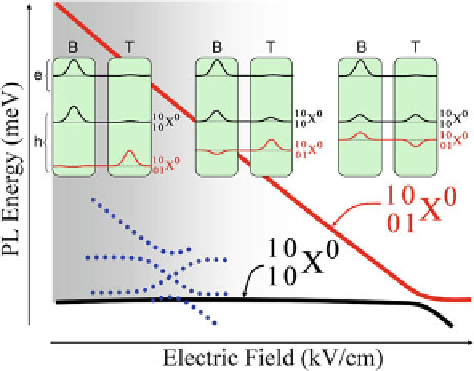Biomedical Engineering Reference
In-Depth Information
Fig. 11.3
Representation of the interdot (
1
0
1
X
0
,
red
) and intradot (
1
1
0
X
0
,
black
) exciton states. The
blue dotted lines
represent the positively charged exciton states. The qualitative behavior of the
electron and hole molecular wavefunctions is shown in the sequence of
green boxes
. As the QDM
is tuned, with decreasing electric field, the holes become increasingly localized. We also note the
linear field dependence of the interdot configuration
There is a continuous change in the QCSE of excitons as a function of the
separation between the constituent QDs (Fig.
11.4
). This can be understood in
terms of carrier separation, the formation of molecular wavefunctions, Coulomb
interactions, and the differing effective masses for the electron and hole [
30
].
In a QDM the electron and hole become increasingly delocalized with smaller
barrier resulting in a change in both the linear (dipole moment) and quadratic
(polarizability) terms of the QCSE for the exciton. For the current discussion we
will neglect the quadratic term and show results for a simple fit of the PL biasmap
data to only a linear component [
31
,
32
]. Even with this simple approximation the
effects of molecular wavefunction formation can be seen in the deviation from the
approximation where the electron and hole remain fixed as the barrier is reduced
(dashed lines in Fig.
11.4
). Though a detailed discussion of these effects including
the quadratic contribution is beyond the scope of this chapter, a simple picture is that
as the QDs are brought closer together the electron and hole symmetric molecular
wavefunctions will shift toward the center of the molecule [
30
]. Due to its smaller
effective mass, this will occur to a larger degree for the electron leading to a reversal
of the typical dipole moment associated with a single QD for the intradot exciton
and a deviation from the linear barrier-dependent behavior for the interdot exciton.
As the barrier is increased, the interdot exciton oscillator strength will decrease
leading to a reduction in the observed PL intensity. Therefore, in the remainder of
the chapter we will focus on the barrier separation of 4 nm. In these samples we find
an excellent balance of a strongly linear interdot Stark shift and reasonable intensity.

